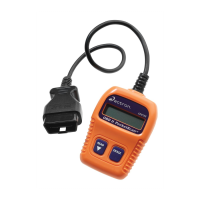
Do you have a question about the Actron OBD II PocketScan Code Reader CP9125 and is the answer not in the manual?
| Power Source | Vehicle's OBD II port |
|---|---|
| Compatibility | OBD II compliant vehicles |
| Display | LCD |
| Connectivity | OBD II |
| Features | Reads and erases diagnostic trouble codes (DTCs) |
| Functions | Diagnostic trouble code (DTC) reading and clearing |
| Supported Protocols | J1850 PWM, J1850 VPW, ISO9141-2, ISO14230-4 (KWP2000), ISO15765-4 (CAN) |
Defines DANGER, WARNING, CAUTION, and IMPORTANT signal words used in the manual.
Lists essential safety practices for operating the code reader and vehicle.
Codes used to help determine the cause of a problem with a vehicle.
Codes also referred to as 'continuous monitor codes' and 'maturing codes'.
Indicates the Malfunction Indicator Lamp on the vehicle should be ON.
Indicates the Malfunction Indicator Lamp should be off.
Lists various emission system monitors and their expanded names.
Defines 'Ready' and 'Inc' (Incomplete) status for monitors.
Methods to clear monitors, such as using the erase codes function.
Steps to prepare the vehicle and connect the OBD II scanner.
Steps to start the scan and review codes, MIL status, and monitors.
Steps to prepare the vehicle and initiate the data erasing process.
Steps to confirm erasure and observe the completion message.
Details items on the CD and the PC system requirements for its use.
Procedure for setting up the computer and launching applications from the CD.
Provides crucial reminders and tips regarding Diagnostic Trouble Codes.
Information on how to obtain further DTC definitions from the provided CD.
Defines the structure of Powertrain, Chassis, Body, and Network Communication codes.
Covers warranty disclaimer, remedies, and procedures for claims and repairs.
